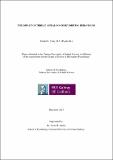| dc.description.abstract | A threat appeal is a form of persuasive communication that aims to change behaviour through the presentation of threatening material. Despite their widespread use in road safety campaigns, the empirical research exploring the impact of threat appeals on driving behaviour has reported inconsistent findings. While a number of studies have found that threat appeals can be effective, provided certain factors are incorporated into their design, methodological and conceptual inconsistencies have made it difficult to draw generalised conclusions. The primary aim of the current research is to examine the effectiveness of threat-based road safety advertisements in reducing risky driving behaviours, among young male drivers in Ireland. This research examined the role of threat, cognitions, and emotions on risky driving, and involved a trilogy of experimental studies (Studies 2-4), which were informed by the existent empirical literature, and the findings of a meta-analytic review (Study 1). Study 1 (k = 13) used meta-analytic techniques to measure the overall impact of threat appeals on fear arousal and driving behaviours. Study 2 (n = 61) examined subjective (i.e. self-report) and objective (i.e. physiological) fear responses to threat-based road safety messages. Study 3 (n = 62) examined the impact of a fear arousing, high threat road safety advertisement on the speeding behaviour of young male drivers. Study 4 (n = 81) investigated the impact of state anger on the effectiveness of the message, reflecting growing interest in the impact of mood on risky decision-making. Findings from the meta-analysis suggest that threat appeals had a strong impact on fear arousal, but that, overall, their effect on behavioural outcomes was weak. Study 2 isolated a threat appeal that elicited a physiological fear response. Study 3 found that the presentation of a high threat road safety advertisement, when combined with increased levels of perceived threat and efficacy, led to a decrease in speeding behaviour. Finally, Study 4 indicated that increased levels of state anger negatively impacted on the effectiveness of a threat appeal. Overall, findings suggest that threat appeal road safety messages have the potential to reduce a number of risky driving behaviours, but that their effectiveness is likely to be impacted by cognitions, such as perceived efficacy, and by state variables, such as anger. Findings are considered in the context of effective road safety advertisement design, and future research in the area. | en_US |


